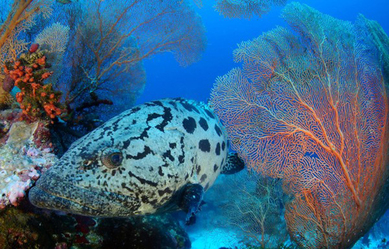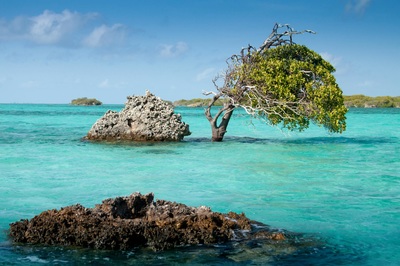|
Hermit crabs can live for more than 30 years in their natural habitats on tropical seashores. They are very social, and need pals, they thrive in large colonies, where they often sleep piled up together. They enjoy climbing, foraging, and exploring, and they even collaborate in teams to find food.
Their gills require high humidity in order to breathe and as their skin doesn’t stretch and grow like ours does, they need very deep, damp sand to burrow under in order to molt. Source: SIF & peta.org The ever changing conditions and strict rules also affect the flora in Aldabra... They are coded to survive, even with the tiniest bit of soil around their roots, salt sprays and strong sun.
In addition, similarly to the inner islands, the southeast monsoon provides very little fresh water in the southern atolls. For some of the species the way of adaption is to loose their leaves and going back to the "stand-by". After, when the rains of the northwestern monsoon approach the islands, they start to flourish again. Photos and info source: SIF Under the #timingiseveything a new photo collage was posted on the SIF Aldabra Reserach Team's FB page. The post reminds us how fragile a turtle population is.
The number of eggs in a nest (clutch) varies by species. On average, turtles lay 110 eggs in a nest. The largest clutches are laid by hawksbills, which may lay over 200 eggs in a nest. Once the female completed the nesting, she never returns to it. The nest's temperature determines the hatchling's gender. Warmer temperature produces mostly females, and cooler temperature produces a majority of males. (Another unfortunate side effect of global warming can be it's result on future population's gender rate.) Turtle eggs look like ping-pong balls, with a soft shell. Mortality rates for turtle eggs are high due to predation by ghost crabs or humans. Some nests are laid to close to the tide line and if not relocated will be lost. When the time comes and hatchlings break free from their shell inside the egg chamber, they stimulate the others to emerge from their eggs too. Once most hatchlings have emerged from their shells, they climb on top of each other and the discarded eggshells til they reach the top of the chamber. They emerge either en masse or in small groups, but emerging together increases the chance of survival. Sea turtles are attracted to light, therefore they are guided by the moonlight reflecting on the sea. As a result of light pollution (street lights, house & hotel lights) they may become victims of predators or accident. If hatchlings delay in emerging from the nest, the heat of the sun also may harm them. On the way to the sea The dangers are not over, on their way to the sea, predators as crabs, birds, fish and sharks are waiting for them. If they survive all these, human caused threats as fishing gear (long line), ingestion of marine debris, boat strikes, trash on beaches and pollution also harms the population. As a result, only one hatchling in a thousand make it to adulthood (15-25 yrs). In Aldabra itself, crabs, crows and herons are waiting for the newly emerged hatchlings on the shore, and many blacktip reef sharks in the shallows. Only a very lucky few reach the open sea's "safety". Source: Sea Turtle Conservancy Photo: SIF Aldabra FB page  Recent video, published by SIF spotlights dugongs at Aldabra. However the atoll is their last refuge in the Seychelles, the featured dugong allowed the SIF team to get quite close. The encounter took place at the lagoon near Ile Esprit. The Animal Diversity Web's summarizes a wide range of information about these mammals. (Photo was made by T Mahoune, and featured on FB, meanwhile the video was edited by AJ Burt)
Earlier this year, during an exploratory walk on Grande Terre (near Cinq Cases), Dr. Dennis Hansen, from the ZARP research team came across some fossils in a dried out pond.
It turned out, that the fossils are from the long extinct Aldabra crocodile. The fossils might trace back to around 120,000 years ago, and have been been preserved in the limestone champignon. The fossils will be examined by the scientists at the University of Zurich, who specializes in crocodiles. Source: Seychelles News Agency Although we have been thinking for a long time to write in details about the residents of Aldabra, a recent post about a cute litte Aldabra rail chick on the SIF FB page made us feature these pictures in a blog post.
The Aldabra rail is believed to be the last surviving flightless bird in the western Indian Ocean, after the extinction of its distant relatives, the Mauritian dodo and the Rodrigues solitaire. It is the flightless subspecies of the white-throated rail (Dryolimnas cuvieri) or Cuvier's rail, from te family Rallidae. (Another subspecies was the D. c. abbotti (Assumption rail), from Assumpption, which went extinct in the early 20th century due to introduced predators.) The Aldabra rail has a slender build, with a long neck, legs and feet. The plumage is chestnut coloured on the body and head, and white on the throat. The fairly long, straight bill is dark, with bright pink base at females, and dull or dark red base at males. Juveniles generally have darker plumage than adults. The wings are short and are often held close to the body. (Description from wikipeadia and Arkive.org) Its natural habitats are subtropical or tropical moist lowland and mangrove forests. A researcher at the Seychelles Islands Foundation (SIF), Dr Janske van de Crommenacker was working on proving that the Aldabra rail is a separate species of bird endemic to Aldabra. She has extracted DNA from museum specimens of the three rail sub-species; Aldabra Rails, Assumption Rails and Madagascar Rails. Many of the samples date back to 100 years ago and were supplied by the Natural History Museum of London. Aldabra rails previously became extinct on Picard due to the introduction of cats, and has been re- introduced from other islands of the atoll, Polymnie, Malabar and Ile aux Cedres in 2002. Source: Seychelles News Agency "On a hillside in Victoria, Mahé’s historic center, stands an unusual church clock that chimes twice—once on the hour, then again a few minutes later. I think of it as a metaphor for Seychelles: a second chime for a second chance, ringing out the rescue of robins, beetles, pitcher plants, and palms, a celebration of nature restored." - Kennedy Warne Great article about restoration, protection of native species and environment, written by Kennedy Warne, published by National Geographic. Photographer: Thomas P. Peschak In Nov 2016 came the news: the photographer, Thomas Pechak is among the finalists in the Wildlife Photographer of the Year competition in the Invertebrate category. The photo 'Crabzilla' was taken at Aldabra as part of a trip to the atoll for a feature length article on Seychelles for National Geographic magazine. (The full gallery of winning images can be seen here.) After rereading the Seychelles News Agency's article about 2015's first cabin cruise expedition to the outer islands, we recalled the omnivorous grouper's story.
“One of the most exciting aspects of an expedition cruise is the fact that natural events and sightings can help shape the journey. So it is expected that no two expeditions will be exactly alike, because weather, tides and chance encounters with nature will influence day-to-day activities. The Aldabra lagoon is usually filled to the brim with fish, since the Seychelles Islands Foundation (SIF) which manages Aldabra, has imposed a total ban on fishing near the atoll." Last year a giant brownish grouper - over two metres long - swallowed one of our clients’ underwater cameras. The full article, written by John Lablache and Hajira Amla (A once-in-a-lifetime journey – cruise operator resumes trips to far-flung Aldabra Group, January 15, 2015) is available on the Seychelles News Agency's webpage.  Potato Cod in the Seychelles outer islands, photo by Manu San Felix/ Pristine Seas Potato Cod in the Seychelles outer islands, photo by Manu San Felix/ Pristine Seas The official launching of the 30-minutes long National Geographic film took place last Friday at the STC Conference Room. In September 2014, Bill Clinton, former president of the USA announced, that Seychelles will be one of the destinations of the NatGeo's Pristine Seas project. Only 6 months later, the team of 10, including 4 scientists, arrived to Seychelles to conduct the program: an interesting amalgam of scientific research, popularly presented by the efficient media tools of National Geographic. The result is a viewer-friendly film for any audience, with footage made with deep-cameras, drop-cameras, pelagic cameras and our mini-helicopters for aerial photography. The project's not-hidden aim is to influence decision-makers to protect certain regions of the sea. BBC journalist Paul Rose, the expedition's leader knows the islands profoundly, having been worked for many years on a marine science project in Seychelles. He told in the NSA interview that the coral bleaching events of 1998 really damaged the marine ecosystem, but it is slowly recovering, which shows the health of the Seychelles waters. He also added "… you never see this color of water anywhere else in the world" and during one of the dives, a chief scientist just stopped his work – while recording fish – just to enjoy the dive, rating it as one of his top ten dives in the world. Hajira Amla's article, the "National Geographic expedition leader rates Seychelles ocean, coral health among best in the world" (March 21, 2015) is available on the Seychelles News Agency's webpage. More information and video about the National Geographic expedition is available here.  We are all impatiently waiting for the 3D film ‘Aldabra: Once upon an Island’. The Czeck premiere was held in Prague earlier this autumn (19th November), and thanks to the fame of the remote atolls - and to the promotion :), it was the third most watched film on its opening weekend. After the grand premiere in Seychelles, the movie will be widely distributed, and hopefully our interested guests will also have the opportunity to watch it. The 73min long 'adventurous 3D' movie was produced by Starlite Pictures in collaboration with Disney, which explains why the plot of the tale-style family movie is about the community of animals, living in Aldabra. As the story goes on, and we get engrossed with the days & nights of Mamma Tori, Wise Elvi, Buster and the other protagonists, we also get a sneak peak in the life of this under and above water wonderland. As an ending phrase, we can only add, what is regularly said: 'Discover Aldabra before it’s lost!’ - and also the neighboring atolls/coral island, which have risen from the sea, and will probably be washed away again. More details on the film and the trailer can be found at www.aldabra3D.com Some pictures from the filming (photos of Starlite Pictures)After the 14-nights long Aldabra expedition, MV Maya's Dugong is back to port, with a handful of guests aboard.
|
Archives
October 2017
Categories
All
|
Aldabra Expeditions - Eco and Dive cruise with Silhouette Cruises Ltd
|
LOCATION
|
|


























 RSS Feed
RSS Feed